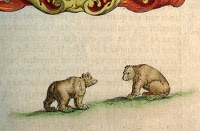As part of our ten-year celebration we are highlighting everyone in the department. Erin Hammeke, Conservator for Special Collections has been with us for three years. Along with other conservators and staff from Special Collections, she selects items for conservation, designs treatment strategies and carries out those repairs. She works primarily on books from the Rare Book, Manuscript, and Special Collections Library. She documents each treatment using both photographic and written reports which we keep on file for future reference.
When asked about a favorite project, Erin replies:
 “Currently I am working on a volume of De Bry’s account of the New World, and this has been an extremely fun and challenging treatment that has involved paper repair, resewing the text, and rebinding in full calf leather. I am also wrapping up treatment of the Blaeu Atlases, six large Dutch atlases that were printed in the mid-1600s and hand painted with an inspired and vibrant color palette.
“Currently I am working on a volume of De Bry’s account of the New World, and this has been an extremely fun and challenging treatment that has involved paper repair, resewing the text, and rebinding in full calf leather. I am also wrapping up treatment of the Blaeu Atlases, six large Dutch atlases that were printed in the mid-1600s and hand painted with an inspired and vibrant color palette.
Over the past three years that I have spent at Duke, my main focus has been on the conservation of the Jantz Collection of German Baroque materials and German Americana. I love working with this collection because it seems to have everything – both in terms of content (there are materials that pertain to history,  travel, the occult, women’s writings, and more) and in terms of different binding styles and materials. For the most part, I am drawn to the more mundane items and the stories they tell about how they were made, why they were collected, by whom, and how they were used and cared for. I have found the Jantz Collection to be particularly rich with these stories.”
travel, the occult, women’s writings, and more) and in terms of different binding styles and materials. For the most part, I am drawn to the more mundane items and the stories they tell about how they were made, why they were collected, by whom, and how they were used and cared for. I have found the Jantz Collection to be particularly rich with these stories.”
*Top illustrations from: Willem Janszoon Blaeu, “Toonneel des aerdriicx, ofte nievwe atlas, dat is Beschryving van alle landen; nu nieulycx uytgegeven.” (E ff#91 dl.5 – 1654.) Lower illustration: books from the Jantz Collection of German Baroque materials.









 Today I started a pilot project to re-house the
Today I started a pilot project to re-house the  I am keen on giving each package a better enclosure. I want to make a sink mat for each item that will securely hold the glass/papyrus package in place, and allow us to house several in one box without them rubbing against each other. This should also allow individual fragments to be served to patrons in the reading room in a safe manner. Better Enclosures + Better Access = Preservation. Wish me luck!
I am keen on giving each package a better enclosure. I want to make a sink mat for each item that will securely hold the glass/papyrus package in place, and allow us to house several in one box without them rubbing against each other. This should also allow individual fragments to be served to patrons in the reading room in a safe manner. Better Enclosures + Better Access = Preservation. Wish me luck!


 It’s Manuscript Day in the lab, similar to
It’s Manuscript Day in the lab, similar to  As you may know we have been working with the Digital Production Center to
As you may know we have been working with the Digital Production Center to